How to grow Dianthus
There are many species of dianthus, some of which are biennial while others are short-lived perennials. The most well-known and cultivated amongst these are:
- Dianthus plumarius – low-growing, scented, easy to grow evergreen perennials also known as ‘pinks’. This is due not to their colour, but to their serrated edges looking like they have been cut with pinking shears.
- superbus – similar to D. plumarius though with more delicate, wispy flowers and a stronger scent. Also known as ‘fringed pink’
- caryophyllus – better known as ‘carnation’, the taller, florist-favourite evergreen perennials.
- barbatus – also known as ‘sweet Williams’, the highly scented, biennial, cottage garden staples.
Dianthus have been grown by home gardeners for centuries due to their reliably floriferous nature and longevity as cut flowers. Most can be expected flower profusely throughout summer, often having started as early as April (depending on the variety).
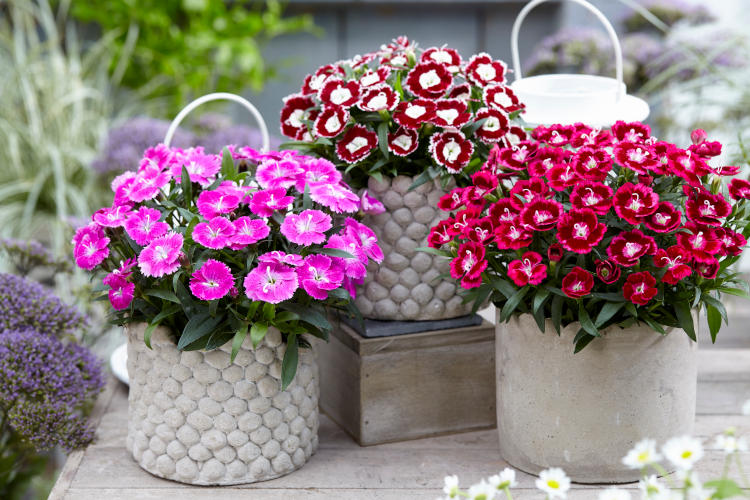
Key Information
Position
Soil Conditions
Hardiness

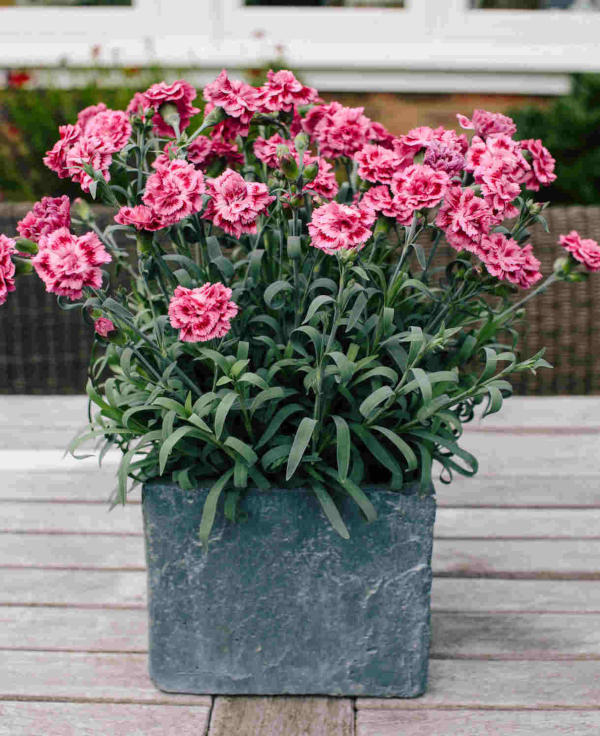
Where & when to plant Dianthus
For best results, plant in autumn or spring. An autumn planting can be done by those gardening in mild conditions (and broadly speaking, this is the southern half of the UK). For those liable to cold winters, it is best to wait until spring (generally the northern half of the UK). Planting can also be carried out in summer, though be prepared to water regularly.
With their compact size and heady scent, pinks (D. plumarius, D. superbus, and their many offspring) are ideal for the front of a border, a rockery, lining a path edge, or growing in a container. The taller carnations (D. caryophyllus) go well in the middle of a border or a cutting garden, where they will need to be supported with thin canes or twigs. Sweet Williams (D. barbatus) fit beautifully into a colourful, busy, cottage garden scheme, woven throughout perennials and annuals to add bright colour and strong scent.
In all cases, choose the sunniest spot available and avoid wet, waterlogged soil.
Position- Full sun
Soil- Well drained, neutral to alkaline soil
Flowering Period- Summer
Hardiness- Most dianthus are rated H4 (-5°C to -10°C) to H7 (-20°C and lower), depending on the species/ cultivar/ series.
How to plant Dianthus
- For planting in the ground, dig the soil area removing any large stones and weeds and breaking up any lumps. Mix in some organic matter such as manure or garden compost. If your soil is on the heavy side, now is also the time to add a generous helping of horticultural grit. Rake level and firm with your heels. Rake level again.
- Prior to planting, water the plants well and allow to drain.
- A good tip is to dig a hole twice the size of the root-ball. Fill with water and allow to drain before placing in the plant.
- Place the plant in the hole, ensuring the top of the root ball sits level with the surface of the soil. Too low and the plant may rot, too high and the roots can dry out.
- Backfill with soil and firm in gently with your foot.
- Soak well with water.
- Mulch around the base with well-rotted organic matter.
- For planting in containers, first choose an appropriate pot with plenty of drainage holes. You might wish to use dianthus as part of a large, mixed container display, or on its own in a smaller container. It can be worth filling large containers in situ to save yourself the trouble of moving once full.
- Prior to planting, water the plants well and allow to drain.
- Use a good quality potting compost with a generous amount of horticultural grit mixed in, and, if not already present in the compost (check the description on the bag) some slow-release fertiliser granules.
- Start by partially filling the pot with compost; enough so that when placed on it the upper surface of the root ball is about 3cm lower than the top of the pot.
- Infill all the space surrounding the root ball with compost, firming down with your fingers then adding a little more so the plant is held tight.
- Pick up the container (if you can!) and lightly tap on the potting bench or ground a few times to help further settle the compost around the plant.
- Soak well with water.
- A mulch with horticultural grit will look attractive and help to prevent a ‘cap’ or crust forming on the top of the compost (something container plants can suffer due to the artificial nature of their watering).
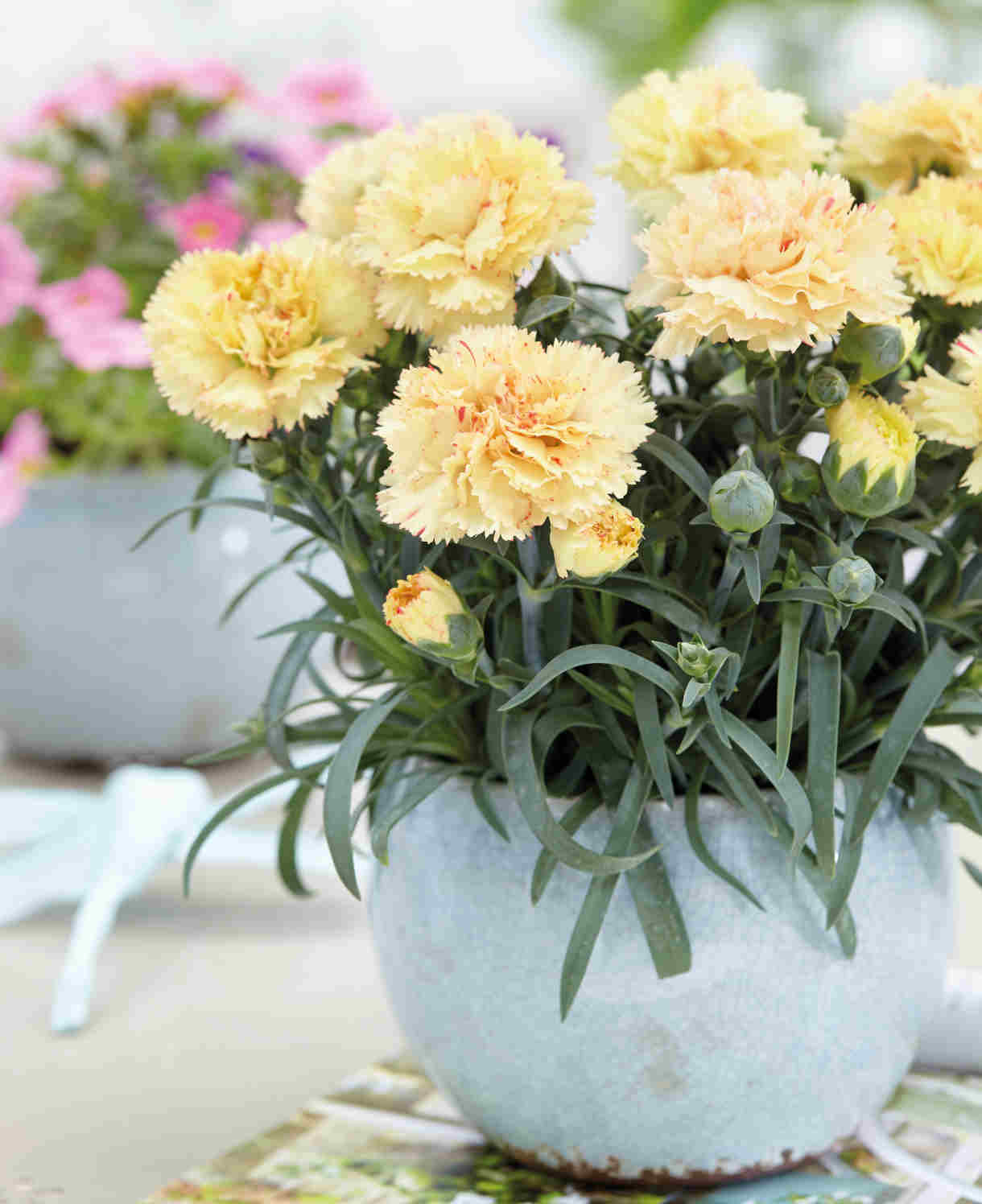
What to plant with Dianthus
Dianthus is one of the ultimate cottage garden plants, and works particularly well in a border overflowing with other sun-loving classics such as verbena, persicaria, kalimeris, and nepeta. A climbing rose clambering up a support with alchemilla and origanum nestling at ground level complete the picture of perfection.

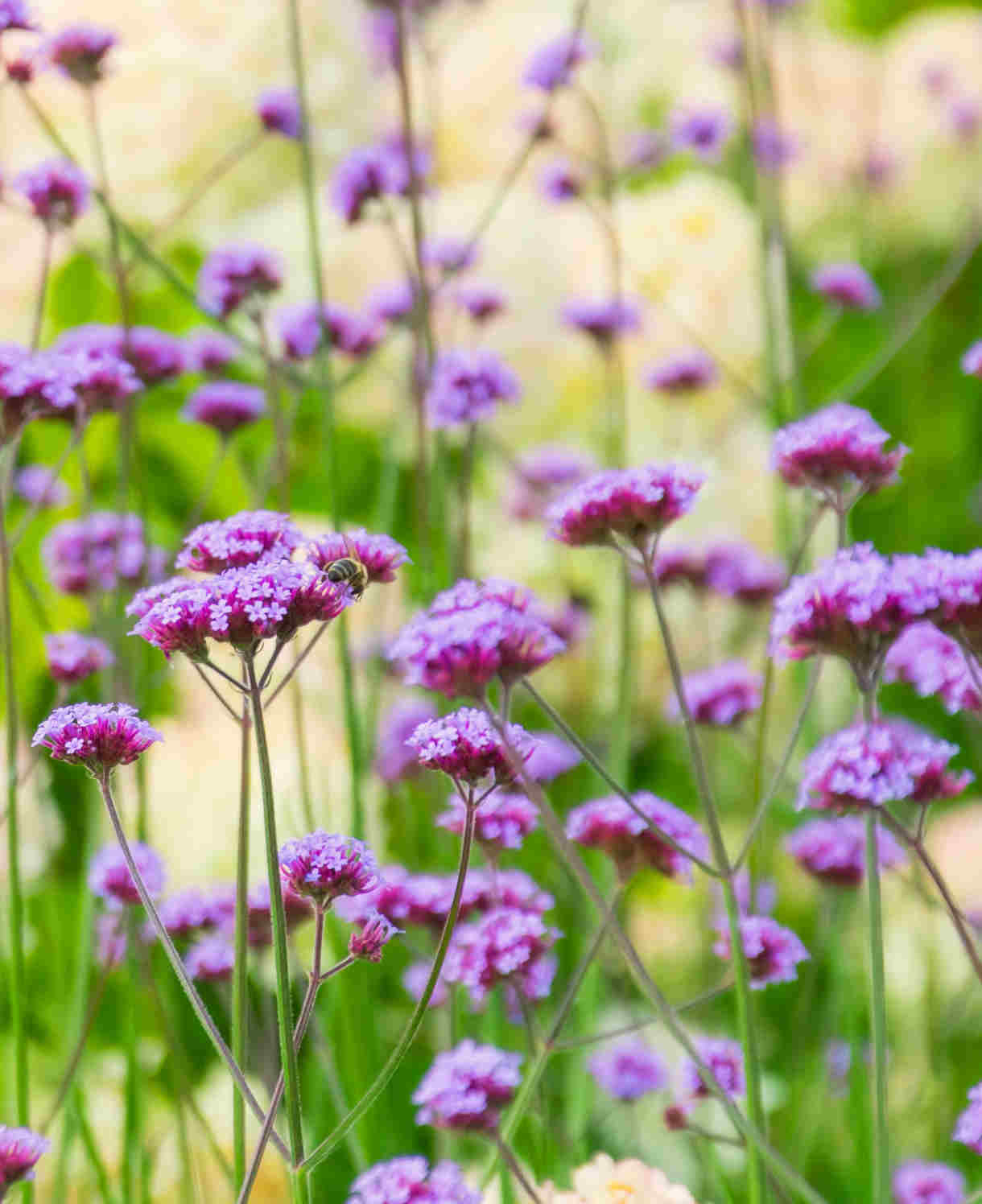
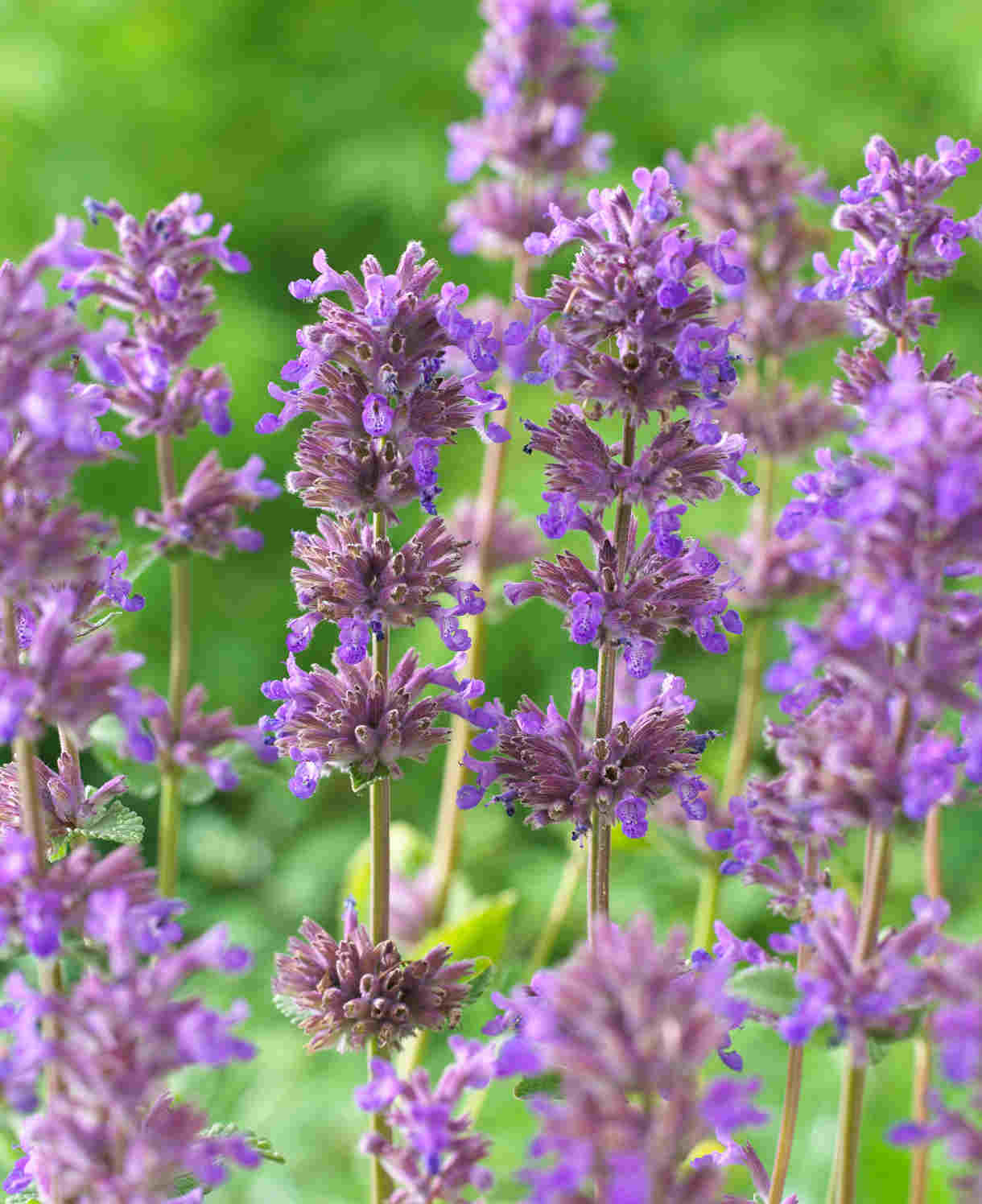
How to care for Dianthus
Pruning and Deadheading
Most species respond to regular deadheading throughout the flowering period by continuing to bloom prolifically (sometimes in flushes rather than continuous flowering). Pinch back the whole flowering stem to the base to encourage nice, bushy regrowth.
The exception to this is older, heritage varieties which may only flower once per growing season.
Biennial species such as D. barbatus can be removed to the compost heap after flowering, while perennial species such as D. plumarius, D. superbus, and D. caryophyllus can be given a tidy up in autumn. Remove any spent flower stems and tatty leaves, then give the remaining foliage a light trim to encourage fresh, smart growth.
It is worth noting that even the perennial species are short-lived, and over time can be expected to become tatty and bare in the middle. Most gardeners find they need replacing about every six years. Fortunately, dianthus come very easily from cuttings (see below), so with a little effort you can ensure a steady supply of new plants for free.
Watering
Newly planted dianthus will need watering every few days. However, they are quick to establish and known to be very drought tolerant from thereon in.
Container-grown dianthus need to be regularly throughout the growing season, though their impressive drought tolerance means the odd period of neglect won’t cause much harm. Allow the top few centimetres of compost to dry out between soakings (check this with your finger) to avoid overwatering. Dianthus resent excessive moisture, so take care to avoid overwatering.
Feeding
On healthy soil, a mulch of well-rotted organic matter (i.e., a good layer of manure or garden compost applied to the soil around the plant) should provide sufficient nutrients for your dianthus, and has the added benefit of suppressing weeds and locking in moisture. Having said this, a dose of tomato feed after deadheading the first flush of flowers can encourage further blooming.
Container-grown plants require more input from the gardener when it comes to their nutrient supply. Get off to a flying start by using a good quality compost, then throughout the growing season (March to September) apply a liquid feed at monthly intervals, mixed according to its instructions. Alternatively, top dress with a general-purpose granular feed every three months.
Cold Protection
Providing they have adequate drainage, most dianthus should be able to survive an average UK winter without the need for additional protection. If you live in a very cold region, you may be better growing yours in a container to allow for overwintering in a more sheltered spot, such as at the base of a south or west-facing wall or even in a cool greenhouse. Wrapping the container with fleece, bubble wrap, or hessian can help to insulate the roots against damage (and prevent the container from cracking in the cold!).
Pests and Diseases
Dianthus tends to be relatively trouble free, though can sometimes find itself weakens by the activity of aphids and slugs.
These ‘pests’ are both part of a balanced garden ecosystem and the best approach is to leave them to their natural predators (e.g. birds, ladybirds, and wasps for aphids, frogs, toads, and hedgehogs for slugs). When numbers are so large, however, that their feeding starts to inhibit and disfigure growth, you may feel it necessary to take action. Regularly blasting aphids off with a hose or wiping away with a cloth or piece of kitchen paper can help to keep numbers down without harming other members of the ecosystem. With slugs, torchlight searches after dark (when they are at their most active) are also effective, allowing you to collect the offending molluscs in a bucket. Place on the compost heap, or in a part of the garden containing less vulnerable plants.
How to propagate Dianthus
Acacia can be propagated by cuttings taken during summer (a good way to insure against winter losses).
- Find non-flowered shoots 5-10cm long and snip off the plant.
- Put them in a plastic bag straight away to prevent drying out.
- Fill a container with a compost mix which is at least 50% perlite (or if you prefer, as we do, 100% perlite).
- Trim the end of the cutting to just below a node (point at which leaves grow).
- Remove the lowest third of leaves.
- If the remaining leaves are large, cut them in half with a sharp knife (to reduce water lost through transpiration).
- Insert the cuttings into the compost and water lightly. Several cuttings can be put in the same container if there is enough space to do this without them touching.
- Place in a greenhouse or propagating unit if you have one or covered with a plastic bag on a windowsill if not (out of direct sunlight).
- Keep the cuttings misted and occasionally watered until they root. You will know this has happened when roots emerge out of the bottom of the container.
- Gently remove rooted cuttings and pot them into individual pots. Grow on in a conservatory or greenhouse until they are large enough to be planted out.
Common Dianthus questions
- Where does dianthus grow best?
Give dianthus a sunny, well-draining spot, avoiding acidic soil if you can, and you won’t go far wrong. - Do dianthus plants spread?
While they don’t have a spreading habit, many dianthus will self-seed throughout an area unless spent flowers are removed. Seedlings can easily be hoed or weeded out if not wanted. - Do dianthus grow well in pots?
Yes, particularly low-growing species such as plumarius and D. superbus. In fact, their toughness and drought tolerance makes them very well-suited to life in an occasionally forgotten container or window box. - Will dianthus bloom all summer?
Depending on the species/ cultivar/ series, dianthus may bloom continuously all summer, on and off in flushes, or (as is the case with some older varieties) in one big flush. Check individual descriptions for more information.




